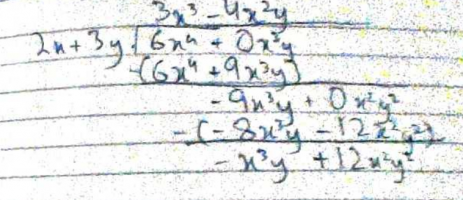You are using an out of date browser. It may not display this or other websites correctly.
You should upgrade or use an alternative browser.
You should upgrade or use an alternative browser.
Division of multivariable polynomials.
- Thread starter askan
- Start date
Dr.Peterson
Elite Member
- Joined
- Nov 12, 2017
- Messages
- 16,861
View attachment 28686
Is it possible to divide this because the method I been told is not working here.
View attachment 28687
It will not divide evenly, as you can see by letting x=3 and y=-2; if (2x+3y) were a factor, you would get 0. So you can expect a remainder.
But also, the second coefficient in your quotient should be -9/2 in order to eliminate -9x^3y. You are, in effect, treating x as the variable and y as a mere parameter, so you need to have a lower degree in x at each step.
Um so yeah is this a method for telling if we can expect a remainder from a division??. If it is then can you tell me more about it.It will not divide evenly, as you can see by letting x=3 and y=-2; if (2x+3y) were a factor, you would get 0. So you can expect a remainder.
ok got it. fractional quotients are to be used here.But also, the second coefficient in your quotient should be -9/2 in order to eliminate -9x^3y.
umm can you explain this a bit more because I didn't understand this part at all.You are, in effect, treating x as the variable and y as a mere parameter, so you need to have a lower degree in x at each step.
Dr.Peterson
Elite Member
- Joined
- Nov 12, 2017
- Messages
- 16,861
Yes. Have you learned the factor theorem? We're just extending it to multiple variables.Um so yeah is this a method for telling if we can expect a remainder from a division??. If it is then can you tell me more about it.
In a sense it should be obvious. If you can write f(x,y) = (2x+3y)(some polynomial), then f(3,-2) = (0)(something) = 0.
You wrote the dividend in order of decreasing degree in x. So you were doing what you would do for 6x^4 - x^2 +x + 4, ignoring the y. But, of course, you can't totally ignore it! I see what you did as dividing (6)x^4 - (y)x^2 +(y^2)x + (4y^4), where the coefficients are 6, -y, y^2, and 4y^4. We're treating y as if it were a constant. That's called a parameter.umm can you explain this a bit more because I didn't understand this part at all.
And at each step of a division, you want to eliminate a term entirely, so you have to subtract the entire (-9y)x^3 in order to make progress. That's how long division works.


